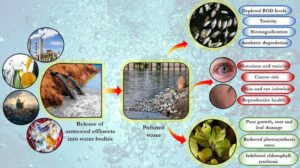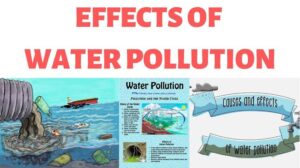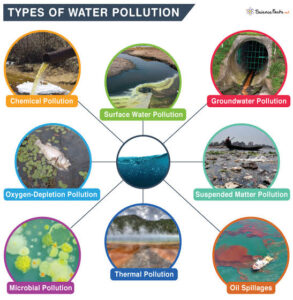Back to: Environmental Biology 400 Level
Welcome to class!
Have you ever seen a river turn black or smell bad, with fish floating lifelessly on the surface? Maybe you’ve heard of communities in the Niger Delta where people can’t drink or fish from nearby water bodies anymore. This is water pollution—one of Nigeria’s most pressing environmental issues—and today, you’ll understand what causes it, how it affects aquatic life, and why aquatic toxicology is so important for protecting ecosystems and public health.
Water Pollution & Aquatic Toxicology
What is Water Pollution?
Water pollution happens when harmful substances—like chemicals, waste, or pathogens—are released into rivers, lakes, streams, or oceans, making the water unsafe for use by humans, animals, or plants. Pollution can come from single sources (like a pipe from a factory) or diffuse sources (like farm runoff after rain).

Sources of Water Pollution
Industrial Effluents
Industries such as oil refineries, textile, and food processing plants discharge untreated or poorly treated wastewater into nearby water bodies. In places like Warri and Eleme, this is a major issue.
Oil Spills and Gas Flaring
Oil spills from pipelines, illegal bunkering, or offshore drilling contaminate rivers and creeks. In Bayelsa and Rivers States, aquatic life and human health have suffered greatly from hydrocarbon pollution.
Domestic Wastewater and Sewage
In many Nigerian cities, sewage is dumped into rivers without treatment. Lagos Lagoon, for instance, receives large volumes of untreated domestic waste.

Agricultural Runoff
Fertilisers and pesticides used on farmlands are washed into streams and rivers by rain, introducing nitrates, phosphates, and toxic chemicals into aquatic ecosystems.
Plastic and Solid Waste
Plastics clog waterways, kill aquatic animals, and contribute to long-term pollution. Markets and urban slums contribute heavily to this, especially along the Ogun and Osun Rivers.
What is Aquatic Toxicology?
Aquatic toxicology is the study of how pollutants affect organisms living in water, such as fish, algae, and amphibians. It helps scientists and policymakers understand which chemicals are harmful, at what concentrations, and how to reduce or eliminate those risks.
Impacts of Water Pollution on Aquatic Life
Bioaccumulation: Toxins like mercury and pesticides build up in fish tissues, making them unsafe to eat.
Eutrophication: Excess nutrients cause algal blooms, which reduce oxygen in water and kill fish.
Reproductive and Developmental Effects: Pollutants disrupt the ability of aquatic organisms to reproduce and grow properly.

Loss of Biodiversity: Entire species of fish and aquatic plants may disappear from polluted rivers.
Nigerian Case Study: Ogoni Land Pollution
The United Nations Environment Programme (UNEP) found that groundwater in Ogoniland was severely polluted with benzene and hydrocarbons from decades of oil spills. Residents could not drink the water, farm, or fish. Aquatic toxicology helped guide the clean-up efforts and monitor recovery.
Summary
- Water pollution occurs when harmful substances contaminate water bodies.
- Major Nigerian sources include industrial waste, oil spills, domestic sewage, and farm runoff.
- Aquatic toxicology studies the impact of pollutants on aquatic organisms.
- Effects include bioaccumulation, eutrophication, fish death, and biodiversity loss.
- The Ogoni case shows how water pollution affects lives and why scientific monitoring is essential.
Evaluation
- Define water pollution and aquatic toxicology.
- List three major sources of water pollution in Nigeria.
- What is eutrophication and how does it affect aquatic life?
- Explain bioaccumulation with an example.
- Describe the role of aquatic toxicology in the Ogoniland clean-up.
Every drop of water matters—especially in a nation like Nigeria where water sustains millions of lives and livelihoods. With your growing knowledge in environmental science, you have what it takes to protect and restore our precious aquatic ecosystems. Keep going—Afrilearn is proud of your journey!
